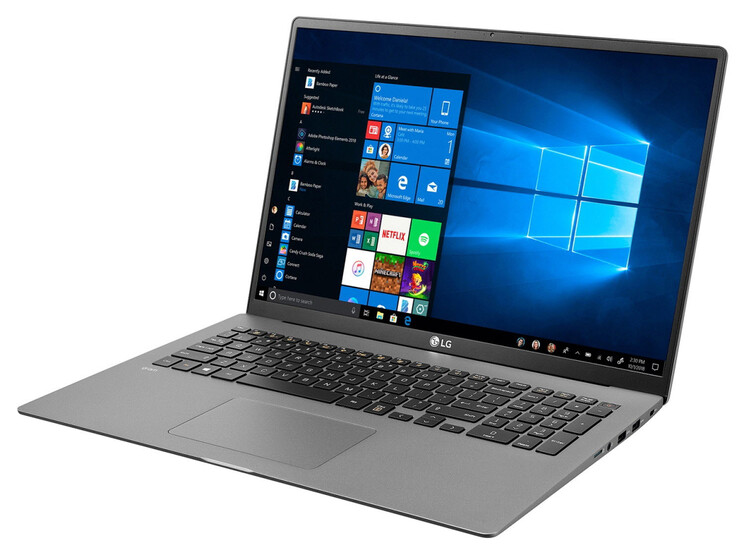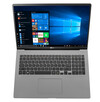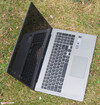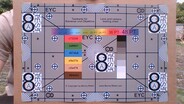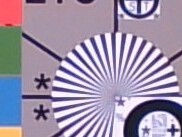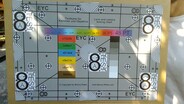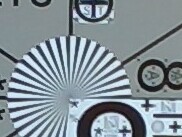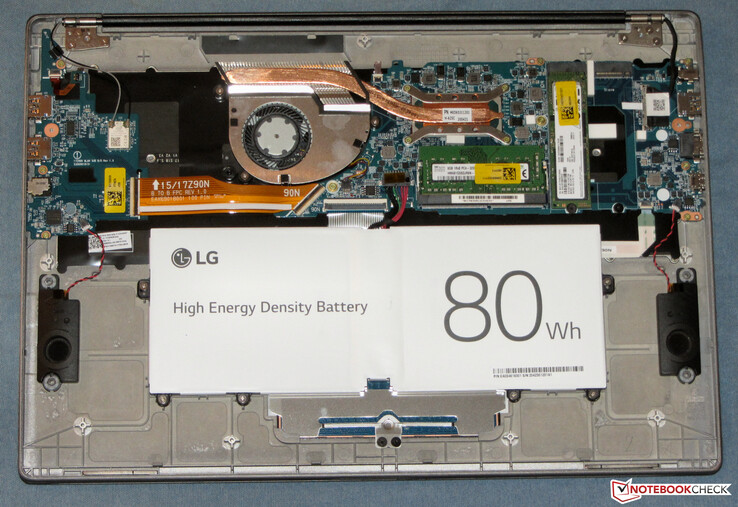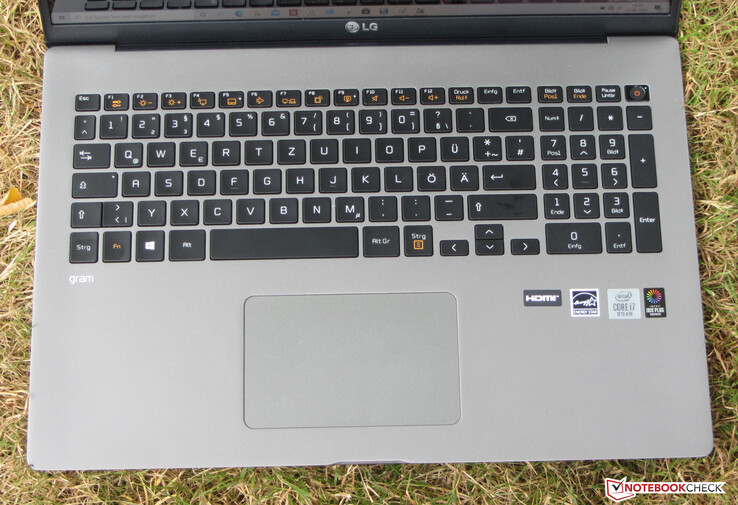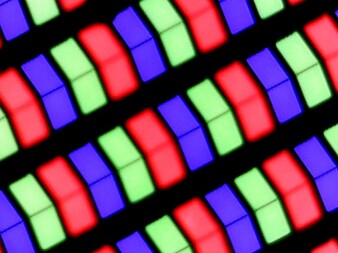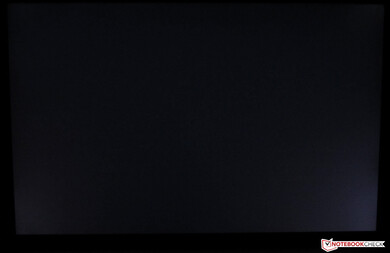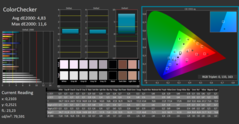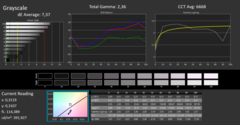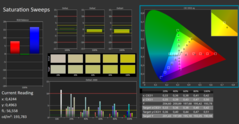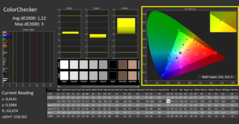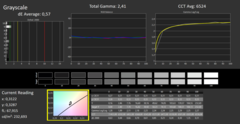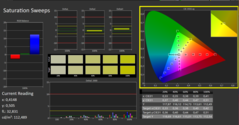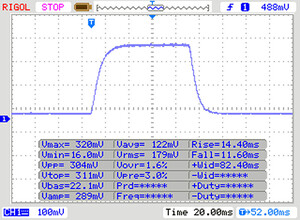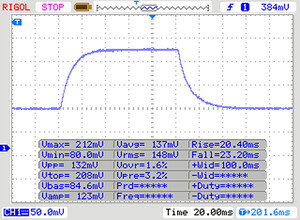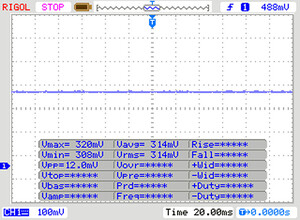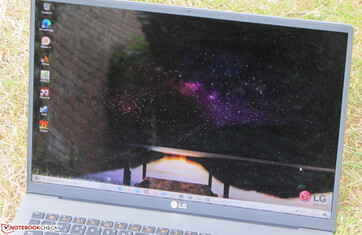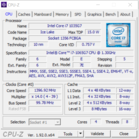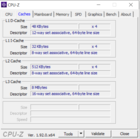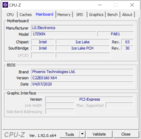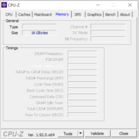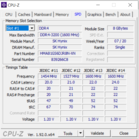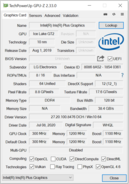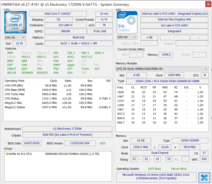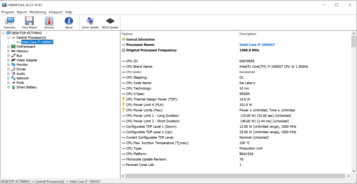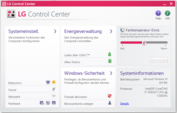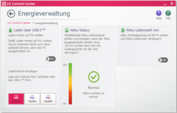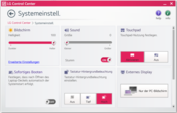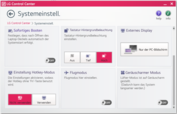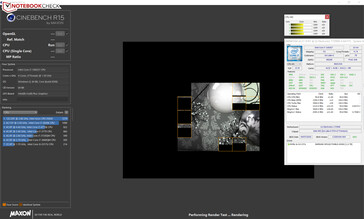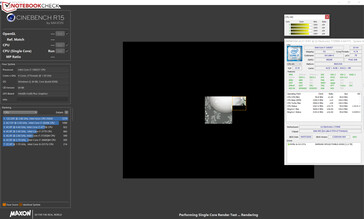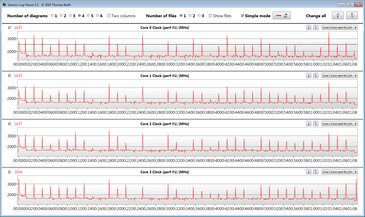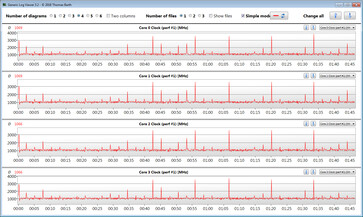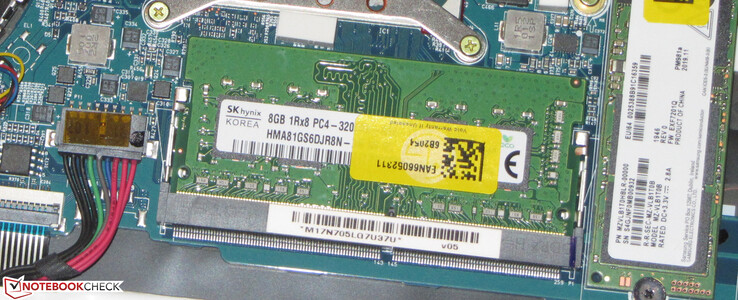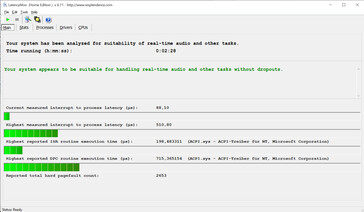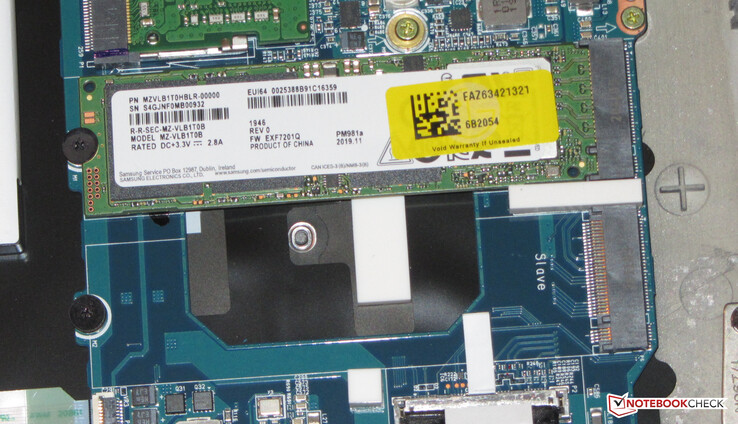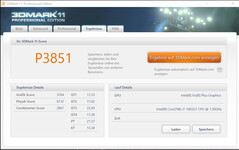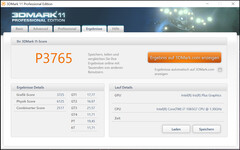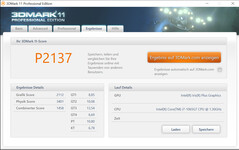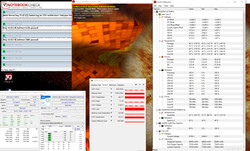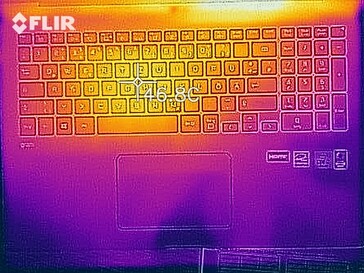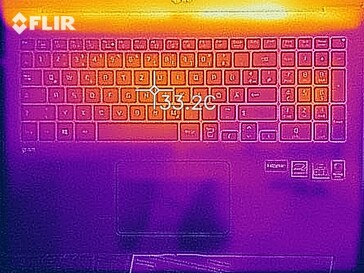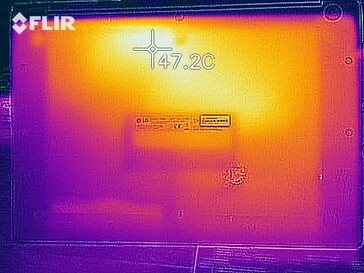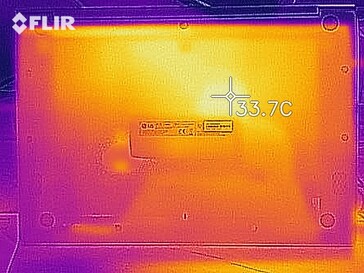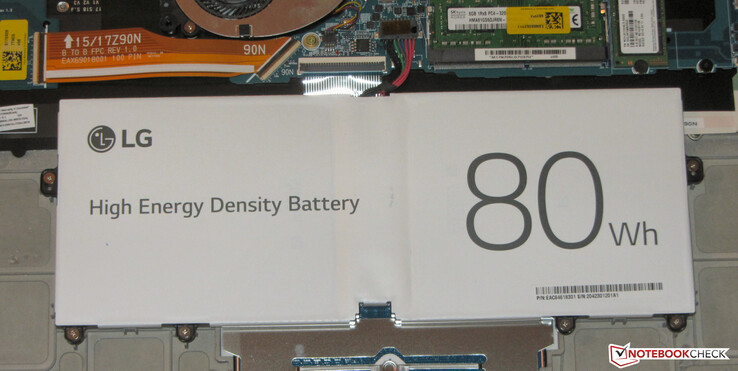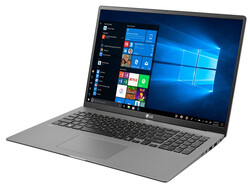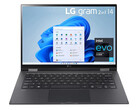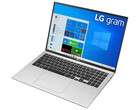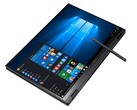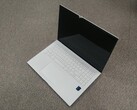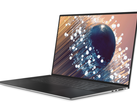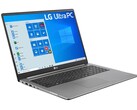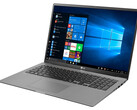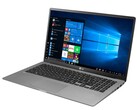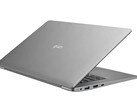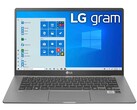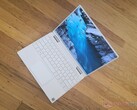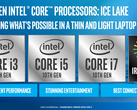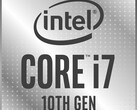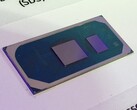LG Gram 17 17Z90N Review: A light and mobile 17-inch laptop with a 16:10 display

Despite its 17-inch format, the LG Gram 17 belongs to the group of slim and mobile office laptops. Its weight of about 1,350 grams (~2.98 lb) remains below that of most 14- and 15.6-inch laptops. You won't find a lighter 17-inch laptop. In addition to the low weight, the 16:10 display represents another selling point of the laptop.
There are no direct competitors in our database. All the 17-inch laptops turn out more bulky, are at least 1 kg (~2.2 lb) heavier, and offer 16:9 displays. While there are some models with 16:10 displays in our database, they are several years old. We are therefore using current 17.3-inch office laptops such as the HP 470 G7, the Asus VivoBook 17 M712DA, and the Medion Akoya P17605 for our comparison.
Rating | Date | Model | Weight | Height | Size | Resolution | Price |
|---|---|---|---|---|---|---|---|
| 85.2 % v7 (old) | 08 / 2020 | LG Gram 17 17Z90N-V.AA77G i7-1065G7, Iris Plus Graphics G7 (Ice Lake 64 EU) | 1.4 kg | 17.4 mm | 17.00" | 2560x1600 | |
| 78.8 % v7 (old) | 06 / 2020 | HP 470 G7 8VU24EA i7-10510U, Radeon 530 | 2.4 kg | 24.5 mm | 17.30" | 1920x1080 | |
| 75.6 % v7 (old) | 01 / 2020 | Asus VivoBook 17 M712DA-AU017T R5 3500U, Vega 8 | 2.3 kg | 21 mm | 17.30" | 1920x1080 | |
| 79.3 % v7 (old) | Medion Akoya P17605 i7-10510U, GeForce MX250 | 2.3 kg | 18.45 mm | 17.30" | 1920x1080 |
Case - The Gram has a magnesium case
When you first touch the very elegant and slim case, you might think that it is made of plastic. But this is not the case. Instead, it uses a magnesium alloy that only brings little weight to the scale. LG provides the silver-gray case ("Dark Silver") with smooth and matte surfaces that are proven to be hardly or not at all susceptible to fingerprints. Despite its very simple design, the case looks very sleek and would look good on any desk. The battery is built in, and there is no maintenance flap.
The device deserves some praise for its excellent workmanship. There are no gaps and no noticeable sharp edges. However, the light build and the magnesium case also require some compromises. The base unit, and even more so the lid, can be warped. While the back of the lid wobbles significantly when applying pressure, there are no changes in the image resulting from the pressure. The hinges hold the display tightly in position but wobble slightly. The maximum opening angle is about 140°, and you can open the display using one hand.
The Gram brings a weight of about 1,350 grams (~2.98 lb) to the scale, which is the same as its predecessor. The case of the new model turns out minimally more compact than the case of the LG Gram 17Z990.
Equipment - Thunderbolt 3 on board
Despite its compact size, LG has equipped the Gram with a solid selection of connections. There are three USB Type-A ports (USB 3.2 Gen 1), which are accompanied by one Thunderbolt-3 port that allows connecting a docking solution or an external GPU. Power delivery and DisplayPort are supported via USB-C, so together with the HDMI port, the notebook offers two video ports. The ports are placed in the back area on the left and right sides, so the areas next to the palm rests will remain free of cables.
SD Card Reader
The LG laptop does not offer a full-size storage card reader, but uses a microSD model instead. With maximum transfer rates of 80.5 MB/s (transfer of 250 jpg image files of about 5 MB each) and 88.9 MB/s (copying large data blocks), it belongs to the faster representatives of its kind. We test the card readers using a reference storage card (Toshiba Exceria Pro M501 microSDXC 64 GB).
| SD Card Reader | |
| average JPG Copy Test (av. of 3 runs) | |
| LG Gram 17 17Z90N-V.AA77G (Toshiba Exceria Pro M501 microSDXC 64GB) | |
| LG Gram 17Z990-R.AAS7U1 (Toshiba Exceria Pro M501 64 GB UHS-II) | |
| Average of class Office (22.4 - 198.5, n=29, last 2 years) | |
| Asus VivoBook 17 M712DA-AU017T (Toshiba Exceria Pro M501 microSDXC 64GB) | |
| HP 470 G7 8VU24EA (Toshiba Exceria Pro SDXC 64 GB UHS-II) | |
| Medion Akoya P17605 (Toshiba Exceria Pro SDXC 64 GB UHS-II) | |
| maximum AS SSD Seq Read Test (1GB) | |
| LG Gram 17 17Z90N-V.AA77G (Toshiba Exceria Pro M501 microSDXC 64GB) | |
| LG Gram 17Z990-R.AAS7U1 (Toshiba Exceria Pro M501 64 GB UHS-II) | |
| Average of class Office (25 - 249, n=27, last 2 years) | |
| Asus VivoBook 17 M712DA-AU017T (Toshiba Exceria Pro M501 microSDXC 64GB) | |
| HP 470 G7 8VU24EA (Toshiba Exceria Pro SDXC 64 GB UHS-II) | |
| Medion Akoya P17605 (Toshiba Exceria Pro SDXC 64 GB UHS-II) | |
Communication
The Intel WLAN chip (Wi-Fi 6 AX201) supports the 802.11a/b/g/n/ac/ax WLAN standards and in addition also offers Bluetooth 5 functionality. The transfer speeds we measure under optimal conditions (no other WLAN devices close by, close distance between laptop and server PC) turn out excellent. In order to support wired network connections, LG also includes a USB-Type-C-to-Ethernet adapter.
| Networking | |
| iperf3 transmit AX12 | |
| LG Gram 17 17Z90N-V.AA77G | |
| Medion Akoya P17605 | |
| Average Intel Wi-Fi 6 AX201 (49.8 - 1775, n=324) | |
| HP 470 G7 8VU24EA | |
| LG Gram 17Z990-R.AAS7U1 | |
| LG Gram 15Z90N | |
| Asus VivoBook 17 M712DA-AU017T | |
| iperf3 receive AX12 | |
| LG Gram 17 17Z90N-V.AA77G | |
| Medion Akoya P17605 | |
| Average Intel Wi-Fi 6 AX201 (136 - 1743, n=324) | |
| HP 470 G7 8VU24EA | |
| LG Gram 15Z90N | |
| LG Gram 17Z990-R.AAS7U1 | |
| Asus VivoBook 17 M712DA-AU017T | |
Webcam
The 0.9 MP webcam produces images with a maximum resolution of 1280x720 pixels. The results turn out slightly washed-out. In addition color accuracy is also lacking, and with a color deviation of about 18, the target (DeltaE < 3) is clearly missed.
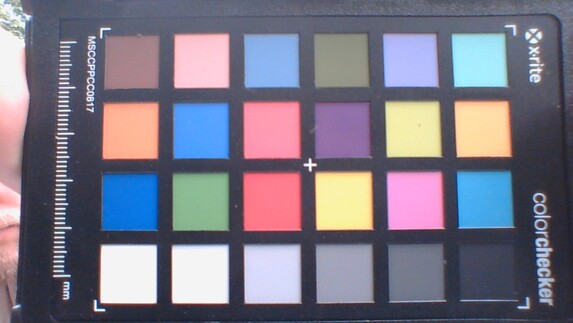
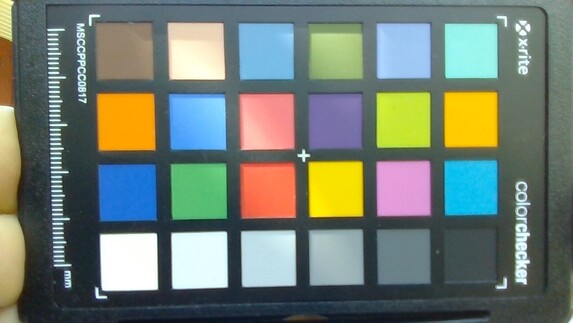
Accessories
In addition to the usual paperwork (warranty information, quick-start instructions), the box also includes a USB-Type-C-to-Ethernet adapter and a transparent rubber mat to protect the keyboard.
Maintenance
The Gram did not turn out particularly maintenance friendly. In order to access the hardware, the bottom of the case has to be removed. Some of the screws are covered by little plastic plates that can be removed using a very small screwdriver or similar tool. The five rubber feet hide more screws. We were able to loosen the glued-in rubber feet with a small plastic spatula.
After all the screws were removed, you have to take off the bottom of the case. You need to be very careful, since the fragile case bottom bends easily. The left and right sides, as well as the front can be unclipped using a spatula or similar prying tool. The back is secured with additional clips that can be loosened by some careful wiggling.
Warranty
LG offers a two-year warranty for the 17-inch laptop. Extending the warranty to five years will cost 120 Euros (~$142).
Input Devices - Gram 17 with keyboard illumination
Keyboard
LG's 17-inch laptop uses an illuminated chiclet keyboard, with keys that offer a short stroke and clear pressure point. The key resistance is basically okay, but could have been a tad crisper for our tastes. All the keys present a smooth surface and that of the main keys is also concave. The keyboard bounces slightly while typing, but this does not turn out to be annoying. The keyboard illumination (two steps of brightness) is controlled via a function key. Overall, LG delivers a keyboard suitable for daily typing tasks here.
Touchpad
The multi-touch capable ClickPad has a footprint of about 12 x 7.8 cm (~4.7 x 3.1 in), offering a lot of space for using gesture controls. The smooth pad surface makes sliding your fingers over it easy, and the pad also responds to input in the corners. It offers a short stroke and a clear pressure point.
Display - 16:10 format with a WQXGA resolution
The LG laptop brings a reflective 17-inch display in the 16:10 format, offering a native resolution of 2560x1600 pixels. The contrast of 1077:1 and brightness of 354 cd/m² are attractive. While the maximum brightness drops slightly in battery operation, it is still more than 300 cd/m². Another positive point is that the display does not produce any PWM flickering at any time.
| |||||||||||||||||||||||||
Brightness Distribution: 84 %
Center on Battery: 340 cd/m²
Contrast: 1077:1 (Black: 0.365 cd/m²)
ΔE ColorChecker Calman: 4.83 | ∀{0.5-29.43 Ø4.77}
calibrated: 1.22
ΔE Greyscale Calman: 7.37 | ∀{0.09-98 Ø5}
93% sRGB (Argyll 1.6.3 3D)
59% AdobeRGB 1998 (Argyll 1.6.3 3D)
63.6% AdobeRGB 1998 (Argyll 3D)
92.7% sRGB (Argyll 3D)
62.9% Display P3 (Argyll 3D)
Gamma: 2.36
CCT: 6668 K
| LG Gram 17 17Z90N-V.AA77G LG Display LP170WQ1-SPA1, IPS, 2560x1600, 17" | LG Gram 17Z990-R.AAS7U1 LG Philips LP170WQ1-SPA1, IPS, 2560x1600, 17" | HP 470 G7 8VU24EA BOE 077B, IPS, 1920x1080, 17.3" | Asus VivoBook 17 M712DA-AU017T BOE084E, IPS, 1920x1080, 17.3" | Medion Akoya P17605 AU Optronics AUO429D, IPS, 1920x1080, 17.3" | LG Gram 15Z90N LP156WF9-SPN1, .2 IPS LED, 1920x1080, 15.6" | |
|---|---|---|---|---|---|---|
| Display | 3% | 5% | -35% | -2% | 5% | |
| Display P3 Coverage (%) | 62.9 | 64.2 2% | 69.1 10% | 40.76 -35% | 62.3 -1% | 66 5% |
| sRGB Coverage (%) | 92.7 | 96.3 4% | 92.3 0% | 59.7 -36% | 88.6 -4% | 96.4 4% |
| AdobeRGB 1998 Coverage (%) | 63.6 | 66.3 4% | 67.5 6% | 42.11 -34% | 63.7 0% | 66.8 5% |
| Response Times | -12% | -9% | 36% | -15% | 14% | |
| Response Time Grey 50% / Grey 80% * (ms) | 43 ? | 42 ? 2% | 42 ? 2% | 24 ? 44% | 45 ? -5% | 36 ? 16% |
| Response Time Black / White * (ms) | 25 ? | 31.2 ? -25% | 30 ? -20% | 18 ? 28% | 31 ? -24% | 22 ? 12% |
| PWM Frequency (Hz) | 250 | |||||
| Screen | 17% | -3% | -30% | 8% | 20% | |
| Brightness middle (cd/m²) | 393 | 370.6 -6% | 280 -29% | 262 -33% | 298 -24% | 366 -7% |
| Brightness (cd/m²) | 354 | 356 1% | 281 -21% | 234 -34% | 294 -17% | 342 -3% |
| Brightness Distribution (%) | 84 | 89 6% | 83 -1% | 84 0% | 88 5% | 88 5% |
| Black Level * (cd/m²) | 0.365 | 0.28 23% | 0.29 21% | 0.265 27% | 0.255 30% | 0.28 23% |
| Contrast (:1) | 1077 | 1324 23% | 966 -10% | 989 -8% | 1169 9% | 1307 21% |
| Colorchecker dE 2000 * | 4.83 | 3.28 32% | 4.18 13% | 5.13 -6% | 3.01 38% | 2.68 45% |
| Colorchecker dE 2000 max. * | 11.6 | 5.85 50% | 7.59 35% | 19.16 -65% | 4.59 60% | 5.25 55% |
| Colorchecker dE 2000 calibrated * | 1.22 | 1.03 16% | 2 -64% | 3.96 -225% | 2.1 -72% | 1.08 11% |
| Greyscale dE 2000 * | 7.37 | 4.9 34% | 5.63 24% | 1.22 83% | 2.29 69% | 2.4 67% |
| Gamma | 2.36 93% | 2.19 100% | 2.44 90% | 2.42 91% | 2.62 84% | 2.25 98% |
| CCT | 6668 97% | 6376 102% | 6801 96% | 6584 99% | 6655 98% | 6474 100% |
| Color Space (Percent of AdobeRGB 1998) (%) | 59 | 60.8 3% | 60 2% | 38 -36% | 58 -2% | 61 3% |
| Color Space (Percent of sRGB) (%) | 93 | 96.6 4% | 92 -1% | 59 -37% | 89 -4% | 96 3% |
| Total Average (Program / Settings) | 3% /
11% | -2% /
-2% | -10% /
-23% | -3% /
4% | 13% /
17% |
* ... smaller is better
The display offers a decent color reproduction already in the state of delivery. However, with a Delta-E 2000 color deviation of almost 5, it misses the target (DeltaE < 3). The display does not suffer from a blue tint. You can achieve further improvement via calibration. The color deviation then drops to 1.22 and the Grayscale reproduction is more balanced. The AdobeRGB (59%) and sRGB (93%) color spaces are not completely covered.
Display Response Times
| ↔ Response Time Black to White | ||
|---|---|---|
| 25 ms ... rise ↗ and fall ↘ combined | ↗ 14 ms rise | |
| ↘ 11 ms fall | ||
| The screen shows relatively slow response rates in our tests and may be too slow for gamers. In comparison, all tested devices range from 0.1 (minimum) to 240 (maximum) ms. » 58 % of all devices are better. This means that the measured response time is worse than the average of all tested devices (20.2 ms). | ||
| ↔ Response Time 50% Grey to 80% Grey | ||
| 43 ms ... rise ↗ and fall ↘ combined | ↗ 20 ms rise | |
| ↘ 23 ms fall | ||
| The screen shows slow response rates in our tests and will be unsatisfactory for gamers. In comparison, all tested devices range from 0.165 (minimum) to 636 (maximum) ms. » 70 % of all devices are better. This means that the measured response time is worse than the average of all tested devices (31.6 ms). | ||
Screen Flickering / PWM (Pulse-Width Modulation)
| Screen flickering / PWM not detected | |||
In comparison: 53 % of all tested devices do not use PWM to dim the display. If PWM was detected, an average of 8077 (minimum: 5 - maximum: 343500) Hz was measured. | |||
LG has equipped the Gram with an IPS panel with stable viewing angles, allowing you to read the display from any position. While the brightness and contrast would allow reading the display outdoors, the reflective display surface usually makes this very difficult.
Performance - Sufficient for office and Internet
With the Gram 17, LG offers a mobile 17-inch laptop that is targeted toward private and professional users. The laptop offers more than sufficient computing power for office and Internet applications. Our test unit is available for about 1,700 Euros (~$2,010). Other equipment configurations are also available with prices starting at about 1,280 Euros (~$1,513; about $1,400 in the US).
Processor
LG uses a Core i7-1065G7 quad-core processor (Ice Lake) from Intel. This ULV model has a basic clock speed of 1.3 GHz, which can be increased via Turbo up to 3.4 GHz (four cores) or 3.9 GHz (single core). Hyper-Threading (two threads running per core) is supported.
The multithread tests of the Cinebench benchmarks run at 2.7 to 2.9 GHz for a short time period in the beginning, before the clock speed drops to 1.9 - 2.1 GHz. The single-thread tests run at 3.4 - 3.9 GHz, and in battery operation, the clock speeds are between 1.5 and 3.4 GHz (single and multithread).
We evaluate whether the CPU Turbo is also used constantly in mains operation by running the multithread test of the Cinebench R15 benchmarks for at least 30 minutes in a constant loop. From the first to the second run, the results drop sharply, and the Turbo is used at a very low level.
The Core i7 clearly remains behind the Core i7-8565U processor used in the predecessor. The Ice Lake processor only maintains a computing performance at the same level for very brief performance peaks. The 1065G7 is also unable to move ahead of the Core i5-1035G7 processor of the LG Gram 15. The results of the remaining benchmarks are also relatively close together, showing that the Core i7 does not bring any advantage. Most users will be better served with the more affordable Core-i5 model of the Gram 17.
The LG Control Center offers the option to activate a silent mode, where the CPU runs at speeds that are reduced even more and the fan remains quiet most of the time. The multithread performance then drops even sharper than the single-thread performance. However, the latter is significantly more important in everyday operation, so the laptop can still be used without any problems.
| Cinebench R15 | |
| CPU Single 64Bit | |
| Average of class Office (99.5 - 312, n=83, last 2 years) | |
| Medion Akoya P17605 | |
| Average Intel Core i7-1065G7 (141 - 190, n=35) | |
| LG Gram 17Z990-R.AAS7U1 | |
| HP 470 G7 8VU24EA | |
| LG Gram 17 17Z90N-V.AA77G | |
| LG Gram 15Z90N | |
| LG Gram 17 17Z90N-V.AA77G (Geraeuscharmer Modus) | |
| Asus VivoBook 17 M712DA-AU017T | |
| CPU Multi 64Bit | |
| Average of class Office (246 - 3380, n=83, last 2 years) | |
| Average Intel Core i7-1065G7 (288 - 836, n=36) | |
| Asus VivoBook 17 M712DA-AU017T | |
| Medion Akoya P17605 | |
| LG Gram 15Z90N | |
| LG Gram 17 17Z90N-V.AA77G | |
| LG Gram 17Z990-R.AAS7U1 | |
| HP 470 G7 8VU24EA | |
| LG Gram 17 17Z90N-V.AA77G (Geraeuscharmer Modus) | |
| Blender - v2.79 BMW27 CPU | |
| LG Gram 17 17Z90N-V.AA77G (Geraeuscharmer Modus) | |
| LG Gram 17 17Z90N-V.AA77G | |
| LG Gram 15Z90N | |
| Average Intel Core i7-1065G7 (675 - 1650, n=23) | |
| HP 470 G7 8VU24EA | |
| Average of class Office (158 - 1956, n=84, last 2 years) | |
| HWBOT x265 Benchmark v2.2 - 4k Preset | |
| Average of class Office (1.72 - 26, n=82, last 2 years) | |
| Average Intel Core i7-1065G7 (2.2 - 6.38, n=22) | |
| HP 470 G7 8VU24EA | |
| LG Gram 17 17Z90N-V.AA77G | |
| LG Gram 17 17Z90N-V.AA77G (Geraeuscharmer Modus) | |
| LibreOffice - 20 Documents To PDF | |
| LG Gram 17 17Z90N-V.AA77G (Geraeuscharmer Modus) | |
| Average Intel Core i7-1065G7 (46.9 - 85.3, n=19) | |
| LG Gram 17 17Z90N-V.AA77G | |
| Average of class Office (41.5 - 129.6, n=82, last 2 years) | |
| HP 470 G7 8VU24EA | |
| LG Gram 15Z90N | |
| R Benchmark 2.5 - Overall mean | |
| LG Gram 15Z90N | |
| LG Gram 17 17Z90N-V.AA77G (Geraeuscharmer Modus) | |
| LG Gram 17 17Z90N-V.AA77G | |
| HP 470 G7 8VU24EA | |
| Average Intel Core i7-1065G7 (0.661 - 0.798, n=18) | |
| Average of class Office (0.4098 - 1.06, n=82, last 2 years) | |
* ... smaller is better
System Performance
The combination of the quad-core processor, NVMe-SSD, and working memory running in dual-channel mode ensures a fast and smoothly running system. While the laptop was not designed for top performance, it offers more than sufficient performance for office and Internet applications. The results in the PCMark benchmarks turn out to be good.
| PCMark 8 Home Score Accelerated v2 | 3305 points | |
| PCMark 8 Creative Score Accelerated v2 | 3872 points | |
| PCMark 8 Work Score Accelerated v2 | 4654 points | |
| PCMark 10 Score | 4293 points | |
Help | ||
DPC Latencies
| DPC Latencies / LatencyMon - interrupt to process latency (max), Web, Youtube, Prime95 | |
| LG Gram 15Z90N | |
| HP 470 G7 8VU24EA | |
| LG Gram 17 17Z90N-V.AA77G | |
* ... smaller is better
Storage Solution
| LG Gram 17 17Z90N-V.AA77G Samsung PM981a MZVLB1T0HBLR | LG Gram 15Z90N SK Hynix PC401 512GB M.2 (HFS512GD9TNG) | HP 470 G7 8VU24EA WDC PC SN520 SDAPNUW-512G | Asus VivoBook 17 M712DA-AU017T Intel SSD 660p SSDPEKNW512G8 | Medion Akoya P17605 Phison E12-256G-Phison-SSD-B16-BB1 | LG Gram 17Z990-R.AAS7U1 Samsung SSD PM871b MZNLN256HAJQ | Average Samsung PM981a MZVLB1T0HBLR | |
|---|---|---|---|---|---|---|---|
| CrystalDiskMark 5.2 / 6 | -3% | -20% | -36% | -6% | -56% | -1% | |
| Write 4K (MB/s) | 162.8 | 177.1 9% | 190.6 17% | 132 -19% | 213.2 31% | 89.7 -45% | 139.7 ? -14% |
| Read 4K (MB/s) | 51 | 47.88 -6% | 49.01 -4% | 52 2% | 59.2 16% | 36.59 -28% | 49.9 ? -2% |
| Write Seq (MB/s) | 2078 | 2182 5% | 1108 -47% | 973 -53% | 1124 -46% | 422.4 -80% | 2036 ? -2% |
| Read Seq (MB/s) | 1991 | 1900 -5% | 1077 -46% | 1606 -19% | 1156 -42% | 454.9 -77% | 2014 ? 1% |
| Write 4K Q32T1 (MB/s) | 440.1 | 448.4 2% | 429.3 -2% | 210.4 -52% | 588 34% | 321.1 -27% | 461 ? 5% |
| Read 4K Q32T1 (MB/s) | 450.1 | 470.3 4% | 544 21% | 312.2 -31% | 612 36% | 340.1 -24% | 499 ? 11% |
| Write Seq Q32T1 (MB/s) | 2998 | 2228 -26% | 1458 -51% | 982 -67% | 1112 -63% | 509 -83% | 2903 ? -3% |
| Read Seq Q32T1 (MB/s) | 3562 | 3454 -3% | 1734 -51% | 1847 -48% | 3121 -12% | 545 -85% | 3479 ? -2% |
| Write 4K Q8T8 (MB/s) | 1283 | 1491 ? | |||||
| Read 4K Q8T8 (MB/s) | 1052 | 1499 ? | |||||
| AS SSD | -4% | -13% | -41% | 6% | -59% | 15% | |
| Seq Read (MB/s) | 2722 | 2842 4% | 1531 -44% | 1592 -42% | 2482 -9% | 454.5 -83% | 2553 ? -6% |
| Seq Write (MB/s) | 2649 | 974 -63% | 1379 -48% | 900 -66% | 1079 -59% | 461 -83% | 2084 ? -21% |
| 4K Read (MB/s) | 52.2 | 50.5 -3% | 43.09 -17% | 45.24 -13% | 59.3 14% | 30.18 -42% | 53.1 ? 2% |
| 4K Write (MB/s) | 132.4 | 147.5 11% | 130.2 -2% | 104.3 -21% | 194.6 47% | 71 -46% | 131.2 ? -1% |
| 4K-64 Read (MB/s) | 886 | 1191 34% | 1040 17% | 324 -63% | 1180 33% | 369.6 -58% | 1477 ? 67% |
| 4K-64 Write (MB/s) | 1074 | 1275 19% | 1138 6% | 835 -22% | 1058 -1% | 305.5 -72% | 1805 ? 68% |
| Access Time Read * (ms) | 0.041 | 0.043 -5% | 0.058 -41% | 0.058 -41% | 0.047 -15% | 0.084 -105% | 0.04983 ? -22% |
| Access Time Write * (ms) | 0.03 | 0.027 10% | 0.029 3% | 0.047 -57% | 0.019 37% | 0.05 -67% | 0.04222 ? -41% |
| Score Read (Points) | 1211 | 1526 26% | 1236 2% | 528 -56% | 1488 23% | 445 -63% | 1786 ? 47% |
| Score Write (Points) | 1471 | 1520 3% | 1406 -4% | 1030 -30% | 1361 -7% | 423 -71% | 2144 ? 46% |
| Score Total (Points) | 3309 | 3741 13% | 3274 -1% | 1810 -45% | 3552 7% | 1106 -67% | 4826 ? 46% |
| Copy ISO MB/s (MB/s) | 2096 | 1135 -46% | 1236 -41% | 816 -61% | 2098 ? 0% | ||
| Copy Program MB/s (MB/s) | 395.6 | 346 -13% | 442.4 12% | 614 55% | 500 ? 26% | ||
| Copy Game MB/s (MB/s) | 1096 | 665 -39% | 830 -24% | 414.9 -62% | 1132 ? 3% | ||
| Total Average (Program / Settings) | -4% /
-3% | -17% /
-16% | -39% /
-39% | 0% /
1% | -58% /
-58% | 7% /
9% |
* ... smaller is better
Constant Performance Reads: DiskSpd Read Loop, Queue Depth 8
Graphics Card
Intel's Iris Plus Graphics G7 graphics core is responsible for the graphics output. The GPU supports DirectX 12 and reaches operating speeds of up to 1100 MHz. The results in the 3DMark benchmarks turn out to be decent but remain behind the capabilities of the GPU.
Note that the 3DMark results of the Gram 17 and the Gram 15 show significant differences despite having the same GPU, since the working memory of the Gram 15 runs in single-channel mode.
| 3DMark 11 Performance | 3851 points | |
| 3DMark Cloud Gate Standard Score | 8356 points | |
| 3DMark Fire Strike Score | 2174 points | |
| 3DMark Fire Strike Extreme Score | 744 points | |
| 3DMark Time Spy Score | 744 points | |
Help | ||
| 3DMark 11 - 1280x720 Performance GPU | |
| Average of class Office (1468 - 18313, n=77, last 2 years) | |
| Average Intel Iris Plus Graphics G7 (Ice Lake 64 EU) (2112 - 4630, n=28) | |
| Medion Akoya P17605 | |
| LG Gram 17 17Z90N-V.AA77G | |
| LG Gram 15Z90N | |
| HP 470 G7 8VU24EA | |
| LG Gram 17 17Z90N-V.AA77G (Geraeuscharmer Modus) | |
| LG Gram 17Z990-R.AAS7U1 | |
Gaming Performance
The Gram is not a gaming laptop. Regardless of this, the built-in hardware is able to bring quite a few games to the screen smoothly. This includes games that don't pose particularly high demands. Usually playable frame rates can be achieved at low resolutions and low to medium quality settings. In some cases, things turn out even better. However, since the CPU and GPU remain behind their full capabilities, overall the frame rates turn out lower than with other Core i7-1065G7 laptops.
| BioShock Infinite - 1366x768 High Preset | |
| Average Intel Iris Plus Graphics G7 (Ice Lake 64 EU) (21.1 - 61.5, n=18) | |
| HP 470 G7 8VU24EA | |
| LG Gram 17 17Z90N-V.AA77G | |
| LG Gram 15Z90N | |
| Tomb Raider - 1366x768 High Preset AA:FX AF:8x | |
| Average Intel Iris Plus Graphics G7 (Ice Lake 64 EU) (41.4 - 49.4, n=2) | |
| HP 470 G7 8VU24EA | |
| LG Gram 17 17Z90N-V.AA77G | |
| low | med. | high | ultra | |
|---|---|---|---|---|
| Tomb Raider (2013) | 100.2 | 64.4 | 41.4 | 22.8 |
| BioShock Infinite (2013) | 79.6 | 49.8 | 42.9 | 16.3 |
| Dota 2 Reborn (2015) | 54.8 | 39.1 | 26.7 | 24.7 |
| X-Plane 11.11 (2018) | 31.7 | 17.5 | 16.1 | |
| Total War: Three Kingdoms (2019) | 42.6 | 12.8 | 6.9 | 5 |
Emissions - The LG computer runs quietly or remains silent
Noise Emissions
Over the whole load spectrum, the Gram hardly produces any noise, so it is also suited as a device for working in quiet surroundings. During idle operation, the fan often remains turned off and the laptop operates in complete silence. Under load, the fan hardly revs up. We measure a maximum noise level of 32.7 dB(A) during the stress test.
The operation can become even quieter by activating the Silent Mode in the LG Control Center. However, this will limit the computing performance.
Noise level
| Idle |
| 26 / 26.8 / 27.5 dB(A) |
| Load |
| 32.2 / 32.7 dB(A) |
 | ||
30 dB silent 40 dB(A) audible 50 dB(A) loud |
||
min: | ||
| LG Gram 17 17Z90N-V.AA77G i7-1065G7, Iris Plus Graphics G7 (Ice Lake 64 EU) | HP 470 G7 8VU24EA i7-10510U, Radeon 530 | Asus VivoBook 17 M712DA-AU017T R5 3500U, Vega 8 | Medion Akoya P17605 i7-10510U, GeForce MX250 | LG Gram 15Z90N i5-1035G7, Iris Plus Graphics G7 (Ice Lake 64 EU) | LG Gram 17Z990-R.AAS7U1 i7-8565U, UHD Graphics 620 | Average Intel Iris Plus Graphics G7 (Ice Lake 64 EU) | Average of class Office | |
|---|---|---|---|---|---|---|---|---|
| Noise | -24% | -11% | -18% | -13% | -8% | -9% | 0% | |
| off / environment * (dB) | 26 | 31.2 -20% | 30.3 -17% | 30.3 -17% | 30.7 -18% | 28.1 -8% | 28.4 ? -9% | 24.2 ? 7% |
| Idle Minimum * (dB) | 26 | 32.7 -26% | 30.3 -17% | 32.4 -25% | 30.7 -18% | 28.1 -8% | 28.6 ? -10% | 24.5 ? 6% |
| Idle Average * (dB) | 26.8 | 32.7 -22% | 30.3 -13% | 32.4 -21% | 30.7 -15% | 28.1 -5% | 28.7 ? -7% | 24.7 ? 8% |
| Idle Maximum * (dB) | 27.5 | 32.8 -19% | 30.3 -10% | 32.7 -19% | 31.9 -16% | 28.1 -2% | 29 ? -5% | 25.5 ? 7% |
| Load Average * (dB) | 32.2 | 42 -30% | 31.6 2% | 36.4 -13% | 34 -6% | 35 -9% | 33.4 ? -4% | 33.6 ? -4% |
| Load Maximum * (dB) | 32.7 | 42 -28% | 35.7 -9% | 36 -10% | 34.2 -5% | 37.4 -14% | 37.9 ? -16% | 40.5 ? -24% |
| Witcher 3 ultra * (dB) | 40.7 |
* ... smaller is better
Temperature
Our stress test (with Prime95 and FurMark running for at least one hour) represents an extreme scenario that does not occur in everyday operation. Using this test, we evaluate whether the system also remains stable under full load. Already after a short time, the CPU and GPU speeds are throttled down to 700-800 MHz and 300-500 MHz, respectively, and then remain at that level - in both mains and battery operation.
The laptop never becomes particularly hot at any time. During the stress test, we measure temperatures in the lower 40 °C range (104 °F) in two measurement spots. In everyday operation, the temperatures remain within the green range.
(±) The maximum temperature on the upper side is 41 °C / 106 F, compared to the average of 34.3 °C / 94 F, ranging from 21.2 to 62.5 °C for the class Office.
(±) The bottom heats up to a maximum of 40 °C / 104 F, compared to the average of 36.8 °C / 98 F
(+) In idle usage, the average temperature for the upper side is 26.7 °C / 80 F, compared to the device average of 29.5 °C / 85 F.
(+) The palmrests and touchpad are cooler than skin temperature with a maximum of 27.6 °C / 81.7 F and are therefore cool to the touch.
(±) The average temperature of the palmrest area of similar devices was 27.5 °C / 81.5 F (-0.1 °C / -0.2 F).
| LG Gram 17 17Z90N-V.AA77G i7-1065G7, Iris Plus Graphics G7 (Ice Lake 64 EU) | HP 470 G7 8VU24EA i7-10510U, Radeon 530 | Asus VivoBook 17 M712DA-AU017T R5 3500U, Vega 8 | Medion Akoya P17605 i7-10510U, GeForce MX250 | LG Gram 15Z90N i5-1035G7, Iris Plus Graphics G7 (Ice Lake 64 EU) | LG Gram 17Z990-R.AAS7U1 i7-8565U, UHD Graphics 620 | Average Intel Iris Plus Graphics G7 (Ice Lake 64 EU) | Average of class Office | |
|---|---|---|---|---|---|---|---|---|
| Heat | 7% | 8% | 1% | 5% | 13% | -3% | -1% | |
| Maximum Upper Side * (°C) | 41 | 39 5% | 34 17% | 44.4 -8% | 38 7% | 38.8 5% | 41.1 ? -0% | 40.5 ? 1% |
| Maximum Bottom * (°C) | 40 | 40 -0% | 34.5 14% | 46.2 -16% | 38.6 3% | 36.2 9% | 42.5 ? -6% | 42.7 ? -7% |
| Idle Upper Side * (°C) | 27.8 | 24.9 10% | 27.7 -0% | 24 14% | 26.5 5% | 22.2 20% | 27.9 ? -0% | 27 ? 3% |
| Idle Bottom * (°C) | 28.1 | 24.5 13% | 28 -0% | 24.5 13% | 26.5 6% | 23.6 16% | 29.1 ? -4% | 28.3 ? -1% |
* ... smaller is better
Speakers
The stereo speakers are positioned at the bottom of the case. While they produce a decent sound, it lacks bass. For better sound enjoyment you have to use headphones or external speakers.
LG Gram 17 17Z90N-V.AA77G audio analysis
(±) | speaker loudness is average but good (74 dB)
Bass 100 - 315 Hz
(-) | nearly no bass - on average 24.6% lower than median
(±) | linearity of bass is average (11.5% delta to prev. frequency)
Mids 400 - 2000 Hz
(+) | balanced mids - only 3.7% away from median
(+) | mids are linear (6.3% delta to prev. frequency)
Highs 2 - 16 kHz
(+) | balanced highs - only 3.2% away from median
(+) | highs are linear (6% delta to prev. frequency)
Overall 100 - 16.000 Hz
(±) | linearity of overall sound is average (18.1% difference to median)
Compared to same class
» 31% of all tested devices in this class were better, 6% similar, 63% worse
» The best had a delta of 7%, average was 21%, worst was 53%
Compared to all devices tested
» 38% of all tested devices were better, 8% similar, 55% worse
» The best had a delta of 4%, average was 24%, worst was 134%
Power Management - The LG Gram offers an excellent battery life
Power Consumption
The power consumption of the Gram 17 ranges at normal levels for the built-in hardware. During idle operation, we measure a maximum power consumption of 11.7 watts. During the stress test (Prime95 and Furmark running for at least one hour), the consumption rises up to 34 watts. The maximum of 39.6 watts that we measured is reached in the medium load range. The power supply is rated at 48 watts.
| Off / Standby | |
| Idle | |
| Load |
|
Key:
min: | |
| LG Gram 17 17Z90N-V.AA77G i7-1065G7, Iris Plus Graphics G7 (Ice Lake 64 EU) | HP 470 G7 8VU24EA i7-10510U, Radeon 530 | Asus VivoBook 17 M712DA-AU017T R5 3500U, Vega 8 | Medion Akoya P17605 i7-10510U, GeForce MX250 | LG Gram 15Z90N i5-1035G7, Iris Plus Graphics G7 (Ice Lake 64 EU) | LG Gram 17Z990-R.AAS7U1 i7-8565U, UHD Graphics 620 | Average Intel Iris Plus Graphics G7 (Ice Lake 64 EU) | Average of class Office | |
|---|---|---|---|---|---|---|---|---|
| Power Consumption | -16% | -2% | -38% | 9% | 10% | -6% | -20% | |
| Idle Minimum * (Watt) | 3.2 | 3 6% | 4.2 -31% | 4.2 -31% | 2.9 9% | 2.7 16% | 3.91 ? -22% | 4.49 ? -40% |
| Idle Average * (Watt) | 8.4 | 7.7 8% | 7.9 6% | 9.9 -18% | 7.7 8% | 8.1 4% | 7.33 ? 13% | 7.43 ? 12% |
| Idle Maximum * (Watt) | 11.7 | 9.8 16% | 8.4 28% | 11.6 1% | 11.4 3% | 10.2 13% | 9.16 ? 22% | 8.8 ? 25% |
| Load Average * (Watt) | 39.6 | 52 -31% | 34 14% | 60 -52% | 31.5 20% | 32.7 17% | 39.2 ? 1% | 42.8 ? -8% |
| Load Maximum * (Watt) | 34 | 61 -79% | 43.7 -29% | 64.1 -89% | 32 6% | 34.8 -2% | 49.8 ? -46% | 64.4 ? -89% |
| Witcher 3 ultra * (Watt) | 43 |
* ... smaller is better
Battery Life
The LG 17 offers an excellent battery life. The 17-incher lasted for 11:23 h in our WLAN test (loading websites via a script) and 12:22 h in our video test (Big Buck Bunny short movie with H.264 encoding at FHD running in a loop). The maximum runtime is almost 24 h.
| LG Gram 17 17Z90N-V.AA77G i7-1065G7, Iris Plus Graphics G7 (Ice Lake 64 EU), 80 Wh | HP 470 G7 8VU24EA i7-10510U, Radeon 530, 41.6 Wh | Asus VivoBook 17 M712DA-AU017T R5 3500U, Vega 8, 37 Wh | Medion Akoya P17605 i7-10510U, GeForce MX250, 42.2 Wh | LG Gram 15Z90N i5-1035G7, Iris Plus Graphics G7 (Ice Lake 64 EU), 80 Wh | LG Gram 17Z990-R.AAS7U1 i7-8565U, UHD Graphics 620, 72 Wh | Average of class Office | |
|---|---|---|---|---|---|---|---|
| Battery runtime | -56% | -71% | -59% | 4% | 0% | -7% | |
| Reader / Idle (h) | 24 | 14 -42% | 25.6 7% | 34.8 45% | 22.3 ? -7% | ||
| H.264 (h) | 12.4 | 5.6 -55% | 11.2 -10% | 14.9 ? 20% | |||
| WiFi v1.3 (h) | 11.4 | 4.6 -60% | 3.3 -71% | 4.7 -59% | 12.1 6% | 11.9 4% | 12.6 ? 11% |
| Load (h) | 3.7 | 1.3 -65% | 4.2 14% | 1.9 -49% | 1.823 ? -51% |
Pros
Cons
Verdict
The LG Gram 17 is designed for mobility from the beginning. The hardware of the laptop is covered by an elegant and compact metal case that brings about 1,350 grams (~2.98 lb) to the scale. An 80-Wh battery ensures runtimes of about 11 to 12 hours in practice.
The battery can either be charged via the included proprietary power supply or using a USB charger that is plugged into the Thunderbolt 3 port. The latter also offers the option for a docking solution or connecting an external GPU to the laptop.
While the built-in Core i7-1065G7 processor offers sufficient performance for office and Internet applications, it does not use its full capabilities. The benchmark results hardly differ from the Core i5-1035G7 equipped LG Gram 15. Since the advantage of the Core i7 turns out very low, a Core i5 model is recommended to potential Gram 17 buyers. LG seems to have given priority to silent operation over maximum performance. The laptop hardly produces any noise and only warms moderately at most.
The display in the 16:10 format represents the highlight of the laptop.
The display scores points with ample brightness, a good contrast, stable viewing angles, decent color reproduction, and acceptable color-space coverage. Unfortunately, LG has decided to use a display model with a reflective surface, which runs counter to the mobile aspirations of the laptop. A matte display should also be offered here. Nonetheless, after a short time of using it, you would not want to miss the additional height offered by the panel compared to a 16:9 display. We hope that other manufacturers will also return to the 16:10 display format again.
LG Gram 17 17Z90N-V.AA77G
- 08/26/2020 v7 (old)
Sascha Mölck


